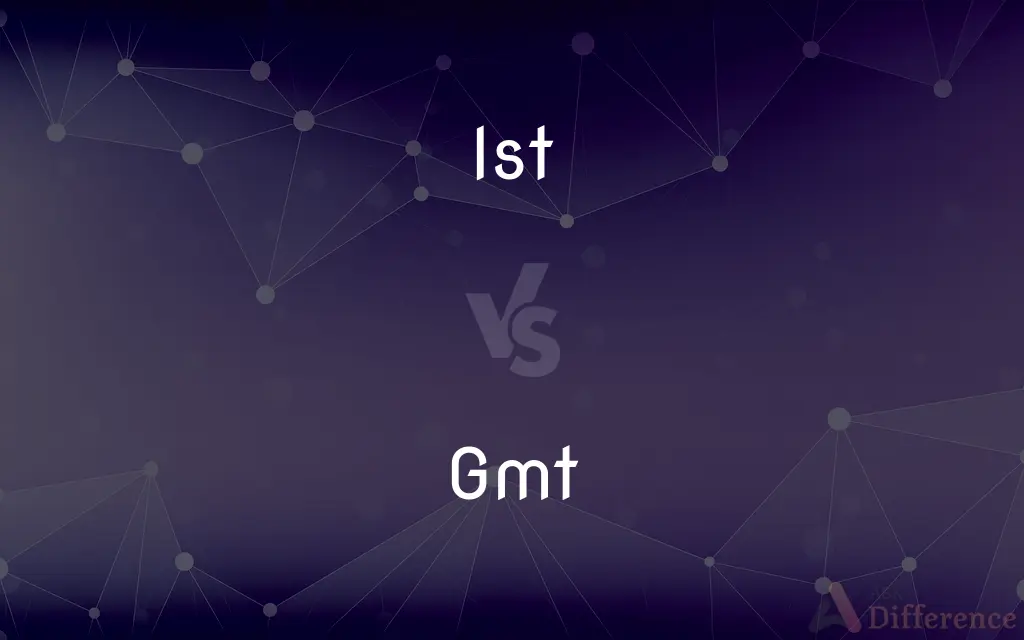IST vs. GMT — What's the Difference?
By Urooj Arif & Fiza Rafique — Updated on March 24, 2024
IST (Indian Standard Time) is the time zone observed throughout India and Sri Lanka, 5.5 hours ahead of GMT (Greenwich Mean Time), which is the mean solar time at the Prime Meridian in Greenwich, London.

Difference Between IST and GMT
Table of Contents
ADVERTISEMENT
Key Differences
IST, or Indian Standard Time, serves as the official time zone for India and Sri Lanka, set at UTC+5:30. This means IST is always 5.5 hours ahead of Coordinated Universal Time (UTC). GMT, or Greenwich Mean Time, is the time measured at the longitude of the Royal Observatory in Greenwich, London, and is used as a basis for time zones worldwide. While GMT used to be the international civil time standard, it has largely been replaced by UTC in that role. However, GMT is still used in some contexts, especially in the UK during the winter months.
The main difference between IST and GMT lies in their geographic reference points and their offset from UTC. IST is fixed at UTC+5:30, providing a single time zone for the entirety of India and Sri Lanka, simplifying timekeeping across these countries despite their wide longitudinal span. On the other hand, GMT aligns with the Prime Meridian (0° longitude) and serves as the baseline from which other time zones are calculated, with no offset from UTC during the winter months.
While IST remains constant throughout the year, GMT can be subject to daylight saving time changes in countries that use it as their standard time, such as the UK, which switches to British Summer Time (BST), one hour ahead of GMT, during the summer months. This shift does not affect the UTC offset, as GMT itself remains constant, but it does mean local time in regions observing GMT will vary.
The adoption of a single time zone like IST simplifies many aspects of life and governance in countries as geographically diverse as India but can also lead to discrepancies in solar time across different regions. GMT, serving more as a global reference point, does not face this issue since it is not used as the standard time across a wide geographic area.
Understanding the relationship between IST and GMT is crucial for international coordination, especially in global communications, travel, and business operations, where accurate timekeeping is essential.
ADVERTISEMENT
Comparison Chart
Definition
The time zone observed throughout India and Sri Lanka, UTC+5:30.
The mean solar time at the Prime Meridian in Greenwich, London, UTC+0.
UTC Offset
+5:30
+0 (No offset)
Geographic Reference
Entire territories of India and Sri Lanka.
Prime Meridian (0° longitude) in Greenwich, London.
Use
Official time for India and Sri Lanka.
Basis for international time zones; used as local time in the UK during winter.
Daylight Saving
Does not observe daylight saving time.
GMT does not change, but regions using it may switch to daylight saving time, e.g., BST in the UK.
Impact
Simplifies timekeeping across diverse regions.
Serves as a global reference point for time zones.
Compare with Definitions
Ist
IST is the time zone for India and Sri Lanka, 5.5 hours ahead of UTC.
When it's 12:00 PM IST, it's 6:30 AM GMT.
Gmt
Does not shift with daylight saving, but local times might.
The UK switches to BST, which is GMT+1, in summer.
Ist
Critical for international coordination with India.
Global businesses plan meetings based on the IST time zone.
Gmt
Basis for UTC, which replaced it in many technical uses.
GMT and UTC are often used interchangeably in common parlance.
Ist
A uniform time standard across India, despite its wide longitudinal range.
IST is used from Gujarat to Arunachal Pradesh.
Gmt
GMT is the mean solar time at the Prime Meridian, used as the world’s time standard.
GMT is referenced to set time zones globally.
Ist
Facilitates unified scheduling across diverse geographical areas.
National broadcasts in India are scheduled in IST.
Gmt
Serves as the UK's standard time during winter months.
London observes GMT from late October to late March.
Ist
Not affected by daylight saving, maintaining a constant UTC+5:30 offset.
IST remains the same throughout the year.
Gmt
Essential for historical timekeeping and astronomy.
GMT was used to standardize time in the 19th century.
Ist
A practitioner or supporter of an ism
Gmt
The local time at the 0 meridian passing through Greenwich, England; it is the same everywhere
Common Curiosities
How is GMT used in the world today?
GMT is a reference point for setting other time zones and is used as standard time in the UK during the winter.
Can GMT and UTC be used interchangeably?
Yes, in most practical contexts, GMT and UTC are used interchangeably, although UTC is more precise for scientific purposes.
What role does the Prime Meridian play in GMT?
The Prime Meridian is the reference line for GMT, marking 0° longitude at Greenwich, where mean solar time is calculated.
Why does India use a single time zone?
India uses a single time zone (IST) for simplicity in governance and daily life, despite its large geographical span.
Does IST change with seasons?
No, IST remains constant at UTC+5:30 throughout the year, not observing daylight saving time.
Is there a difference in how IST and GMT are determined?
Yes, IST is fixed at UTC+5:30, while GMT is based on the solar time at the Greenwich Prime Meridian, serving as the basis for UTC+0.
What is the difference between IST and GMT?
IST is UTC+5:30 and serves as the standard time in India and Sri Lanka, while GMT is UTC+0, marking mean solar time at the Greenwich Prime Meridian.
Why don’t all countries use a single time zone like India?
Countries choose their time zones based on geographical, political, and social factors; a single time zone across large areas can cause practical and social issues.
What time is it in IST when it's 12:00 PM GMT?
When it's 12:00 PM GMT, it's 5:30 PM IST.
How do businesses coordinate between IST and GMT?
Global businesses coordinate by converting between IST and GMT, considering the 5.5-hour difference for scheduling meetings and operations.
Share Your Discovery

Previous Comparison
Lamper vs. Hamper
Next Comparison
Clarificatory vs. ClarificationAuthor Spotlight
Written by
Urooj ArifUrooj is a skilled content writer at Ask Difference, known for her exceptional ability to simplify complex topics into engaging and informative content. With a passion for research and a flair for clear, concise writing, she consistently delivers articles that resonate with our diverse audience.
Co-written by
Fiza RafiqueFiza Rafique is a skilled content writer at AskDifference.com, where she meticulously refines and enhances written pieces. Drawing from her vast editorial expertise, Fiza ensures clarity, accuracy, and precision in every article. Passionate about language, she continually seeks to elevate the quality of content for readers worldwide.















































